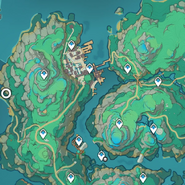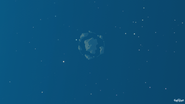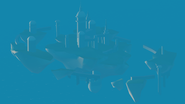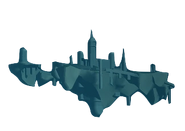Celestia is a mysterious location that very few people understand. It is the floating island that can be seen in the sky above Teyvat, and is the residence of the gods. It is currently controlled by the Heavenly Principles, although they have been silent since the cataclysm 500 years ago.[1]
It is said that only mortals who perform great, heroic feats can ascend to Celestia and achieve godhood, where they will watch over their people from above.[2] All Vision wielders are "allogenes" who have the potential to reach godhood.[3]
Appearance[]
The floating "island" actually seems comprised of several landmasses, with one large central rock and about seven to eight smaller "satellites" positioned around it. These outer rocks are connected with one single ring-like structure which again is held in place with several bridges or arches expanding from the central mass.

All of these foundation rocks appear almost as if torn from the earth at some point in the past, with their surfaces covered in lush plains and forests contrasting the rough, craggy undersides. While a few signs of architecture are visible on the outer rocks, the main focus lies on the central mass, with two discernible structures made out of marble or similar white stone. The first is a smaller spire-topped structure positioned on the rim of the central mass, while the second is the more prominent central multi-storied spire which itself is topped by a massive golden construct, reminiscent of an astrolabe.
Additionally, the architecture of the central mass seems to descend deep below the surface level with a distinct inverted dome peeking out from the very bottom of the rock.
Apart from the mentioned forests and green plains on the upper surfaces of the land masses, it also appears to have several subterranean rivers bursting forth from the rock, gradually diminishing into nothing during their free fall of hundreds of miles from above the ground.
While the overall appearance is still imposing and breathtaking, even at a distance, slight traces of disrepair and wear are noticeable among the bright marble structures with broken-off pieces on the spires and bridges.

A depiction of Celestia can also be found on Tsurumi Island located in a cave below Shirikoro Peak.
Venti claims the water in Celestia tastes foul and their fruit is bland.[4]
Location[]
Celestia's location is roughly west-southwest of the Mt. Mingyuan waypoint as of Version 4.4.
In Teyvat Legend[]

In other, distant worlds...
Pangu gave his blood to form the rivers and seas...
The gods sacrificed Purusha and cut his body to pieces...
...And then fashioned all living beings with those parts.
The brain of the giant Ymir became clouds.
Their sacrifices seeded life in the unliving cosmos.
These songs sing of the primeval ones.
Celestia and those who dwell on it are an enigma to the people of Teyvat. Most people believe it is where chosen mortals ascend to become gods (or in Liyue belief, adepti) and watch over those on Teyvat.[2][6]
Due to the amount of mystery surrounding this island, different accounts about how Celestia operates, and who qualifies for godhood and how, vary significantly. For example, some believe that adepti descended from Celestia and return there when they depart from this world;[7] whilst other sources believe that Guhua, an adeptus, ascended to Celestia instead of dying.[8]
When speaking about Vennessa, the Falcon of the West of the Four Winds who supposedly ascended to Celestia, Dainsleif claims "it ultimately does naught but hover under the light of the gods,"[9] suggesting that even those who ascend to godhood are still considered beneath the Celestial gods, and not as equals.
In the distant past, humans were able to communicate with Celestia directly through heavenly messengers.[10] This came to an end during the war between the Heavenly Principles and the Seelie versus the Seven Sovereigns and the invaders "from beyond the firmament," which ended with the Heavenly Principles sending down the divine nails to prevent the world's collapse. These nails devastated the world below by causing massive, drastic environmental changes — likely a result of their effects on the ley lines.
Relationship to the Gods[]
The Seven Archons can resonate directly with Celestia through their Gnoses,[3] which are symbols of the Heavenly Principles' control over Teyvat and all the laws.[1]
The prevailing belief among scholars in Teyvat is that Celestia instigated the Archon War and established the rules of the war.[11][12] It is unclear whether the gods fought to claim one of seven divine seats in Celestia[11] or if they already had seats in Celestia and lost them upon death,[13] but at the end of the Archon War, the Seven Archons were established out of the victors.
Interestingly, while the Heavenly Principles has been referred to as a single entity, in the Manga's Prologue chapter, Venti recalls three enigmatic, shadowed figures when Vennessa asks about Celestia. He visibly grows uncomfortable at the thought and quickly changes the subject.[5] There is currently no way to determine who those three characters might be, or if they will ever be brought up again.
Trivia[]
- In Gnosticism, above the seven heavens (worlds) presided over by the seven archons is the Ogdoad, a supercelestial region which mortals aspire to reach through gnosis.
- Celestia and its gods may also be inspired by the Demiurge who, in Gnostic beliefs, fashioned and maintains the material universe; he created the seven heavens and created the seven archons to rule over them. The Demiurge himself is the son of Sophia, one of the aspects of Pleroma, but is ignorant of an even-higher existence and thus came to believe himself to be the one and only god. In some Gnostic beliefs, the Demiurge is an antagonistic figure that seeks to prevent mortals from leaving the material universe and ascending to Ogdoad via gnosis.
- When Venti dodges The Traveler's question about whether those who ascend to Celestia truly become gods, the names he mentions — Pangu, Purusha, and Ymir — are names of mythological figures connected to creation myths. A common thread between these three figures is that after their deaths, their body parts were scattered to create the world.
- Before Version 3.0, Celestia was not visible in Inazuma and the Golden Apple Archipelago. After the Version 3.0 update, Celestia is visible from all areas of Inazuma except for most of the subareas on Seirai Island, likely due to the island's purple sky. It is currently unknown whether Celestia will also become visible in the Golden Apple Archipelago.
- It was speculated before Version 3.0 that this was either due to a rendering issue or the fact that neither location has a connection to Celestia, as the Golden Apple Archipelago is no longer inhabited and Ei, Inazuma's archon, severed ties with Celestia.
- At the base of the Anemo Archon Statue in Mondstadt, the words "Gateway to Celestia" can be seen in Teyvat's common language.
Gallery[]
Other Languages[]
| Language | Official Name | Literal Meaning |
|---|---|---|
| English | Celestia | — |
| Chinese (Simplified) | 天空岛 Tiānkōng-dǎo | Sky Island |
| Chinese (Traditional) | 天空島 Tiānkōng-dǎo | |
| Japanese | 天空の島 Tenkuu no Shima | Island of the Open Sky |
| Korean | 셀레스티아 Selleseutia | — |
| Spanish | Celestia | — |
| French | Celestia | — |
| Russian | Селестия Selestiya | — |
| Thai | Celestia | — |
| Vietnamese | ĐảoĐảo Thiên KhôngThiên Không | Sky Island[※][※] |
| German | Celestia | — |
| Indonesian | Celestia | — |
| Portuguese | Celestia | — |
| Turkish | Kutsal Diyar | Divine Realm |
| Italian | Celestia | — |
Change History[]
- The representation of Celestia in the game's skybox was changed from a two-dimensional image to a three-dimensional model.
- Celestia was introduced.
References[]
- ↑ 1.0 1.1 Archon Quest, Chapter III, Act V - Akasha Pulses, the Kalpa Flame Rises, Part 4: Where the Boat of Consciousness Lies
- ↑ 2.0 2.1 NPC Dialogue: Dr. Edith
- ↑ 3.0 3.1 Archon Quest, Prologue, Act III - Song of the Dragon and Freedom, Part 8: Ending Note
- ↑ Venti's Voice-Over: More About Venti: IV
- ↑ 5.0 5.1 Manga, Prologue Chapter: Songs of the Wind
- ↑ NPC Dialogue: Qingzhou
- ↑ NPC Dialogue: Musheng
- ↑ Weapon: Rainslasher
- ↑ World Quest, I: Act IV: Bough Keeper: Dainsleif
- ↑ Artifact Set: Prayers to Springtime
- ↑ 11.0 11.1 World Quest, Part 1: Treasure Lost, Treasure Found
- ↑ Book: A Preliminary Study of Sangonomiya Folk Belief
- ↑ Venti's Character Story: Character Story 4
With the crumbling of an ancient seat of divinity, a new god was born.


















